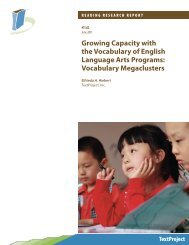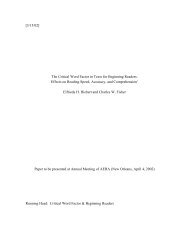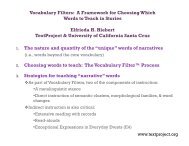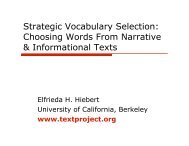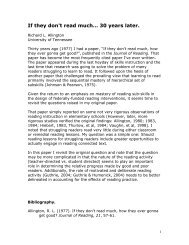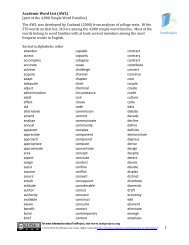Aligning Theory and Assessment of Reading Fluency - Wiley Online ...
Aligning Theory and Assessment of Reading Fluency - Wiley Online ...
Aligning Theory and Assessment of Reading Fluency - Wiley Online ...
Create successful ePaper yourself
Turn your PDF publications into a flip-book with our unique Google optimized e-Paper software.
meeting <strong>of</strong> the American Education Research Association, NewYork, NY.Schwanenflugel, P.J., Kuhn, M.R., Morris, R.D., Morrow, L.M.,Meisinger, E.B., Woo, D.G., et al. (2009). Insights into fluencyinstruction: Short- <strong>and</strong> long-term effects <strong>of</strong> two readingprograms. Literacy Research <strong>and</strong> Instruction, 48(4), 318–336.doi:10.1080/19388070802422415Schwanenflugel, P.J., Meisinger, E., Wisenbaker, J.M., Kuhn, M.R.,Strauss, G.P., & Morris, R.D. (2006). Becoming a fluent <strong>and</strong>automatic reader in the early elementary school years. <strong>Reading</strong>Research Quarterly, 41(4), 496–522. doi:10.1598/RRQ.41.4.4Schwanenflugel, P.J., Morris, R.K., Kuhn, M.R., Strauss, G.P., &Sieczko, J.M. (2008). The influence <strong>of</strong> word unit size on thedevelopment <strong>of</strong> Stroop interference in early word decoding.<strong>Reading</strong> <strong>and</strong> Writing: An Interdisciplinary Journal, 21(3), 177–203.doi:10.1007/s11145-007-9061-2Schwanenflugel, P.J., & Ruston, H.P. (2008). Becoming a fluent reader:From theory to practice. In M.R. Kuhn & P.J. Schwanenflugel(Eds.), <strong>Fluency</strong> in the classroom (pp. 1–16). New York: Guilford.Schwebel, E.A. (2007). A comparative study <strong>of</strong> small group fluencyinstruction—A replication <strong>and</strong> extension <strong>of</strong> Kuhn’s (2005) study.Unpublished master’s thesis, Kean University, Union, NJ.Shanahan, T. (2005, May). Improving instruction for young children:Making sense <strong>of</strong> the National Literacy Panel. Paper presented at theInternational <strong>Reading</strong> Association Preconference Institute #8,San Antonio, TX.Shapiro, E.S. (2004). Academic skills problems: Direct assessment <strong>and</strong>intervention (3rd ed.). New York: Guilford.Shinn, M.R., & Shinn, M.M. (2002). AIMSweb training workbook:Administration <strong>and</strong> scoring <strong>of</strong> reading maze for use in general outcomemeasurement. Eden Prairie, MN: Edformation.Shukla, M., Nespor, M., & Mehler, J. (2007). An interaction betweenprosody <strong>and</strong> statistics in the segmentation <strong>of</strong> fluentspeech. Cognitive Psychology, 54(1), 1–32. doi:10.1016/j.cogpsych.2006.04.002Sibley, D., Biwer, D., & Hesch, A. (2001). Establishing curriculumbasedmeasurement oral reading fluency performance st<strong>and</strong>ards topredict success on local <strong>and</strong> state tests <strong>of</strong> reading achievement. (ERICDocument Reproduction Service No. ED453527)Simpson, E.A., Oliver, W.T., & Fragaszy, D. (2008). Superexpressivevoices: Music to my ears? Behavioral <strong>and</strong> Brain Sciences,31(5), 596–597.Smith, C.L. (2004). Topic transitions <strong>and</strong> durational prosody inreading aloud: Production <strong>and</strong> modeling. Speech Communication,42(3–4), 247–270. doi:10.1016/j.specom.2003.09.004Snedeker, J., & Trueswell, J. (2003). Using prosody to avoid ambiguity:Effects <strong>of</strong> speaker awareness <strong>and</strong> referential context.Journal <strong>of</strong> Memory <strong>and</strong> Language, 48(1), 103–130. doi:10.1016/S0749-596X(02)00519-3Snedeker, J., & Yuan, S. (2008). Effects <strong>of</strong> prosodic <strong>and</strong> lexicalconstraints on parsing in young children (<strong>and</strong> adults).Journal <strong>of</strong> Memory <strong>and</strong> Language, 58(2), 574–608. doi:10.1016/j.jml.2007.08.001Snow, C.E., Burns, M.S., & Griffin, P. (1998). Preventing reading difficultiesin young children. Washington, DC: National AcademyPress.Stahl, S.A., & Heubach, K., & Holcomb, A. (2005). <strong>Fluency</strong>-orientedreading instruction. Journal <strong>of</strong> Literacy Research, 37(1), 25–60.doi:10.1207/s15548430jlr3701_2Stanovich, K.E. (1986). Matthew effects in reading: Some consequences<strong>of</strong> individual differences in the acquisition <strong>of</strong> literacy.<strong>Reading</strong> Research Quarterly, 21(4), 360–407. doi:10.1598/RRQ.21.4.1Stanovich, K.E., Cunningham, A.E., & West, R.F. (1981). A longitudinalstudy <strong>of</strong> the development <strong>of</strong> automatic recognition skills infirst graders. Journal <strong>of</strong> <strong>Reading</strong> Behavior, 13(1), 57–74.Stecker, P.M., & Fuchs, L.S. (2000). Effecting superior achievementusing curriculum-based measurement: The importance <strong>of</strong>individual progress monitoring. Learning Disabilities Research &Practice, 15(3), 128–135. doi:10.1207/SLDRP1503_2Stecker, S.K., Roser, N.L., & Martinez, M.G. (1998). Underst<strong>and</strong>ingoral reading fluency. In T. Shanahan & F.V. Rodriguez-Brown(Eds.), 47th yearbook <strong>of</strong> the National <strong>Reading</strong> Conference (pp. 295–310). Chicago: National <strong>Reading</strong> Conference.Stolterfoht, B., Friederici, A.D., Alter, K., & Steube, A. (2007).Processing focus structure <strong>and</strong> implicit prosody during silentreading: Differential ERP effects. Cognition, 104(3), 565–590.doi:10.1016/j.cognition.2006.08.001Surányi, Z., Csépe, V., Richardson, U., Thompson, J.M., Honbolygó,F., & Goswami, U. (2009). Sensitivity to rhythmic parameters indyslexic children: A comparison <strong>of</strong> Hungarian & English. <strong>Reading</strong><strong>and</strong> Writing, 22(1), 41–56. doi:10.1007/s11145-007-9102-xSweet, A.P., & Snow, C.E. (Eds.). (2003). Rethinking reading comprehension.New York: Guilford.Swets, B., Desmet, T., Hambrick, D.Z., & Ferreira, F. (2007). Therole <strong>of</strong> working memory in syntactic ambiguity resolution: A psychometricapproach. Journal <strong>of</strong> Experimental Psychology. General,136(1), 64–81. doi:10.1037/0096-3445.136.1.64Teale, W.H., Paciga, K.A., & H<strong>of</strong>fman, J.L. (2007). Beginning readinginstruction in urban schools: The curriculum gap ensures acontinuing achievement gap. The <strong>Reading</strong> Teacher, 61(4), 344–348.doi:10.1598/RT.61.4.8Temperley, D. (2009). Distributional stress regularity: A corpusstudy. Journal <strong>of</strong> Psycholinguistic Research, 38(1), 75–92.doi:10.1007/s10936-008-9084-0Thomson, J.M., Fryer, B., Maltby, J., & Goswami, U. (2006). Auditory<strong>and</strong> motor rhythm awareness in adults with dyslexia. Journal <strong>of</strong>Research in <strong>Reading</strong>, 29(3), 334–348. doi:10.1111/j.1467-9817.2006.00312.xTorgesen, J.K., & Hudson, R.F. (2006). <strong>Reading</strong> fluency: Criticalissues for struggling readers. In S.J. Samuels & A.E. Farstrup(Eds.), What research has to say about fluency instruction (pp. 130–158). Newark, DE: International <strong>Reading</strong> Association.Vellutino, F.R., Fletcher, J.M., Snowling, M.J., & Scanlon,D.M. (2004). Specific reading disability (dyslexia): Whathave we learned in the past four decades? Journal <strong>of</strong> ChildPsychology <strong>and</strong> Psychiatry, <strong>and</strong> Allied Disciplines, 45(1), 2–40.doi:10.1046/j.0021-9630.2003.00305.xWayman, M.M., Wallace, T., <strong>Wiley</strong>, H.I., Tichdt, R., & Espin, C.A.(2007). Literature synthesis on curriculum-based measurementin reading. The Journal <strong>of</strong> Special Education, 41(2), 85–120. doi:10.1177/00224669070410020401Wells, B., & Peppe, S. (2003). Intonation abilities <strong>of</strong> children withspeech <strong>and</strong> language impairments. Journal <strong>of</strong> Speech, Language, <strong>and</strong>Hearing Research, 46(1), 5–20. doi:10.1044/1092-4388(2003/001)Wennerstrom, A. (2001). The music <strong>of</strong> everyday speech: Prosody <strong>and</strong>discourse analysis. London: Oxford University Press.Whalley, K., & Hansen, J. (2006). The role <strong>of</strong> prosodic sensitivityin children’s reading development. Journal <strong>of</strong> Research in <strong>Reading</strong>,29(3), 288–303. doi:10.1111/j.1467-9817.2006.00309.xWheeldon, L., & Lahiri, A. (1997). Prosodic units in speech production.Journal <strong>of</strong> Memory <strong>and</strong> Language, 37(3), 356–381.doi:10.1006/jmla.1997.2517Wixson, K.K., & Lipson, M.Y. (2009, May). Response to intervention:Promises, possibilities, <strong>and</strong> potential problems for reading pr<strong>of</strong>essionals.Paper presented at the <strong>Reading</strong> Research Conference,Minneapolis, MN.Wolf, M., & Katzir-Cohn, T. (2001). <strong>Reading</strong> fluency <strong>and</strong> its intervention.Scientific Studies <strong>of</strong> <strong>Reading</strong>, 5(3), 211–229. doi:10.1207/S1532799XSSR0503_2Wood, C. (2006). Metrical stress sensitivity in young children<strong>and</strong> its relationship to phonological awareness <strong>and</strong> reading.250<strong>Reading</strong> Research Quarterly • 45(2)





